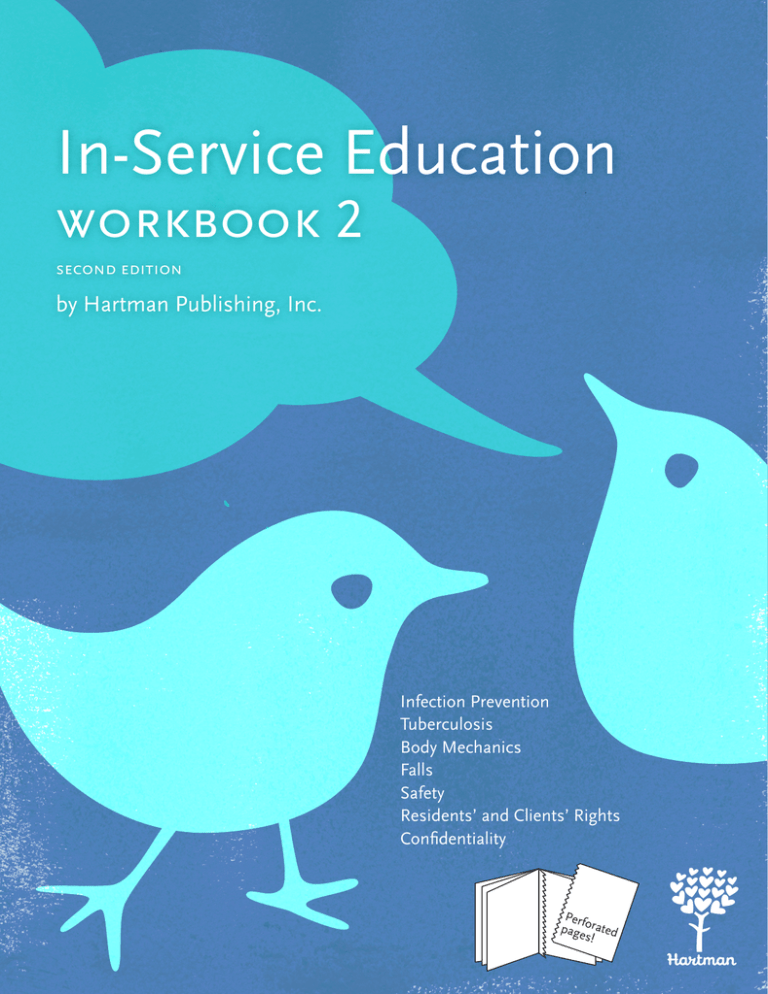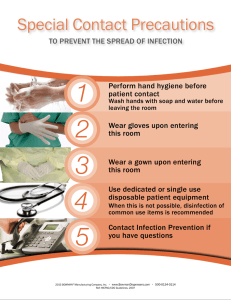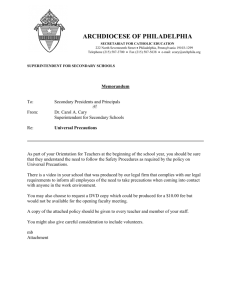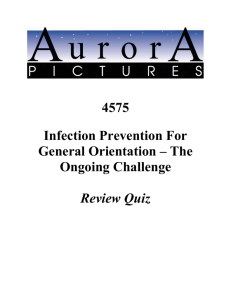
In-Service Education
workbook 2
second edition
by Hartman Publishing, Inc.
Infection Prevention
Tuberculosis
Body Mechanics
Falls
Safety
Residents’ and Clients’ Rights
Confidentiality
Perf
pageorated
s!
In-Service Education
Workbook 2
By Hartman Publishing, Inc.
second edition
ii
Credits
Managing Editor
Susan Alvare Hedman
Copy Editor
Kristin Calderon
Cover Designer
Kirsten Browne
Production
Thad Castillo
Illustration
Thad Castillo
Proofreaders
Kristin Calderon
Kristin Cartwright
Notice to the Reader
Though the guidelines and procedures contained in this text are based on consultations with healthcare professionals, they
should not be considered absolute recommendations. The instructor and readers should follow employer, local, state, and
federal guidelines concerning healthcare practices. These guidelines change, and it is the reader’s responsibility to be aware
of these changes and of the policies and procedures of her or his healthcare facility or agency.
The publisher, author, editors, and reviewers cannot accept any responsibility for errors or omissions or for any consequences from application of the information in this book and make no warranty, express or implied, with respect to the
contents of the book. The publisher does not warrant or guarantee any of the products described herein or perform any
analysis in connection with any of the product information contained herein.
Information about CEUs and In-Service Workbooks
There is a specific number of credits listed at the top of the first page of each in-service, as well as in the table of contents
on the next page. They reflect estimates of the number of CEUs (continuing education units) that might be awarded for
completion of this in-service.
These numbers should serve as a guide only. Hartman Publishing does not assign these credits, nor issue CEUs. Depending upon the state, actual CEU assignment is done by a facility, agency, or state department.
In addition, the instructor and readers should know and follow their state’s guidelines for self-study in-service programs.
Copyright Information
© 2014 Hartman Publishing, Inc. All rights reserved. No part of this book may be reproduced, in any form or by any
means, without permission in writing from the publisher.
ISBN 978-1-60425-046-6
PRINTED IN CANADA
iii
Table of Contents
Preventing Infection (2 credits)
1
Protecting Healthcare Workers and Others from
Tuberculosis (2 credits)
11
Using Proper Body Mechanics (2 credits)
21
Preventing Falls in the Elderly (2 credits)
29
Preventing Accidents and Injuries (2 credits)
39
Understanding and Promoting Residents’ and
Clients’ Rights (3 credits)
49
Maintaining Confidentiality (1 credit)
61
iv
1
Preventing Infection
(2 credits)
After completing this section, the student should be able to do the following:
1. Describe the chain of infection
2. Explain Standard and Transmission-Based Precautions
3. Explain hand hygiene and identify when to wash hands
4. Discuss the use of personal protective equipment (PPE)
5. List guidelines for handling equipment and linen
1. Describe the chain of infection
Infections occur when harmful microorganisms,
called pathogens, invade the body and multiply. To understand how to prevent disease, it is
helpful to first understand how it is spread. The
chain of infection is a way of describing how
disease is transmitted from one being to another
(Fig. 1-1). Definitions and examples of each of
the six links in the chain of infection follow.
Chain Link 3: The portal of exit is any body
opening on an infected person that allows pathogens to leave (Fig. 1-2). These include the nose,
mouth, eyes, or a cut in the skin.
Fig. 1-2. Portals of exit.
Fig. 1-1. The chain of infection.
Chain Link 1: The causative agent is a pathogenic microorganism that causes disease.
Causative agents include bacteria, viruses, fungi,
and parasites.
Chain Link 2: The reservoir is where the
pathogen lives and grows. A reservoir can be
a human, animal, plant, soil, or a substance.
Microorganisms grow best in warm, dark, and
moist places where food is present. Some microorganisms need oxygen to survive while others
do not. Examples of reservoirs include the lungs,
blood, and the large intestine.
Chain Link 4: The mode of transmission describes how the pathogen travels.
Transmission can occur through the air or
through direct or indirect contact. Direct contact
happens by touching the infected person or his
secretions. Indirect contact results from touching something contaminated by the infected person, such as a needle, dressing, or tissue. The
primary route of disease transmission within the
healthcare setting is on the hands of healthcare
workers.
Chain Link 5: The portal of entry is any body
opening on an uninfected person that allows
pathogens to enter (Fig. 1-3). These include the
nose, mouth, eyes, and other mucous membranes, cuts in the skin, and cracked skin.
Chain Link 6: A susceptible host is an uninfected person who could get sick. Examples
2
include all healthcare workers and anyone in
their care who is not already infected with that
particular disease.
is the only safe way that nursing assistants and
home health aides can do their jobs. An NA/
HHA cannot tell by looking at people or even by
reading their medical charts if they have a contagious disease such as tuberculosis, hepatitis, or
influenza.
Standard Precautions include the following
measures:
•
Wash hands before putting on gloves and
immediately after removing gloves.
•
Wear gloves if the person may come into
contact with any of the following: blood;
body fluids or secretions; broken skin, such
as abrasions, acne, cuts, stitches, or staples;
or mucous membranes. Such contacts occur
during mouth care; toilet assistance; perineal care; helping with a bedpan or urinal;
ostomy care; cleaning up spills; cleaning
basins, urinals, bedpans, and other containers that have held body fluids; and disposing
of wastes.
•
Remove gloves immediately when finished
with a procedure.
•
Immediately wash all skin surfaces that have
been contaminated with blood and body
fluids.
•
Wear a disposable gown that is resistant
to body fluids if the person may come into
contact with blood or body fluids or when
splashing or spraying blood or body fluids is
likely.
•
Wear a mask and protective goggles if the
person may come into contact with blood or
body fluids or when splashing or spraying
blood or body fluids is likely.
•
Wear gloves and use caution when handling
razor blades, needles, and other sharps.
Sharps are needles or other sharp objects.
Sharps should be placed carefully in a biohazard container for sharps. These containers are hard, leakproof, clearly labeled, and
warn of the danger of the contents inside
(Fig. 1-4). There are also biohazard bags that
are used for biomedical waste that is not
sharp, such as soiled dressings, contaminated tubing, and other items. Biomedical/
biohazard waste should be disposed of at the
point of origin, or where the waste occurs.
•
Never attempt to recap needles or sharps
after use.
Fig. 1-3. Portals of entry.
If one of the links in the chain of infection is
broken, then the spread of infection is stopped.
Infection prevention practices help stop the
pathogens from traveling (Link 4), and getting
on a person’s hands, nose, eyes, mouth, skin,
etc. (Link 5). Immunizations (Link 6) reduce a
person’s chances of getting sick from diseases
such as hepatitis B and influenza.
2. Explain Standard and TransmissionBased Precautions
In 1996, the Centers for Disease Control (CDC),
cdc.gov, recommended a new infection prevention system to reduce the risk of contracting
infectious diseases in healthcare settings. In
2007 some additions and changes were made to
this system. There are two tiers of precautions
within this system: Standard Precautions and
Transmission-Based, or Isolation, Precautions.
Standard Precautions means treating blood,
body fluids, non-intact skin (like abrasions, pimples, or open sores), and mucous membranes
(linings of mouth, nose, eyes, rectum, and genitals) as if they were infected. Body fluids include
saliva, sputum (mucus coughed up), urine,
feces, semen, vaginal secretions, pus or other
wound drainage, and vomit. They do not include
sweat.
Standard Precautions must be used with every
resident/client. Following Standard Precautions
Name: ________________________________
Preventing Infection
Exam
Multiple Choice. Circle the letter of the correct answer.
1. Which of the following is true of wearing gloves?
(A)Disposable gloves can be washed and reused.
(B) Gloves should be changed before contact with mucous membranes.
(C) After giving care, gloves are not contaminated.
(D) Gloves can continue to be worn if they are torn as long as the hole is covered.
2. Under Standard Precautions, the term body fluids includes
(A) Sweat
(B) Water
(C) Juice
(D) Urine
3. Hand hygiene is
(A) Washing hands with either plain or antiseptic soap and water or using alcohol-based
hand rubs
(B) Washing hands with soap and water only
(C) Using alcohol-based hand rubs only
(D) Wearing gloves when performing care procedures
4. The following are necessary links in the chain of infection. When a caregiver wears gloves,
which link is broken, thus preventing the spread of disease?
(A) Reservoir (place where the pathogen lives and grows)
(B) Mode of transmission (a way for the disease to spread)
(C) Susceptible host (person who is likely to get the disease)
(D) Causative agent (pathogenic microorganism that causes disease)
5. With whom should an NA/HHA use Standard Precautions?
(A) With people who have infectious diseases
(B) With people he suspects might have infectious diseases
(C) With every person in his care
(D) With people who request that they be used
6. Which of the following is the proper order to don PPE?
(A) Put on mask and goggles, gown, and gloves.
(B) Put on gloves, gown, and mask and goggles.
(C) Put on mask and goggles, gloves, and gown.
(D) Put on gown, mask and goggles, and gloves.
7. Which of the following is true of Transmission-Based Precautions?
(A) An NA/HHA does not need to practice Standard Precautions if he practices
Transmission-Based Precautions.
(B) They are exactly the same as Standard Precautions.
(C) They are practiced in addition to Standard Precautions.
(D) They will not be listed in the care plan so as not to alarm anyone.
7




